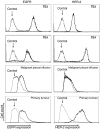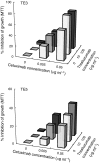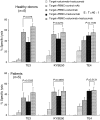Targeting EGFR and HER-2 with cetuximab- and trastuzumab-mediated immunotherapy in oesophageal squamous cell carcinoma
- PMID: 17622245
- PMCID: PMC2360355
- DOI: 10.1038/sj.bjc.6603885
Targeting EGFR and HER-2 with cetuximab- and trastuzumab-mediated immunotherapy in oesophageal squamous cell carcinoma
Abstract
We previously reported that oesophageal squamous cell carcinoma (SCC) had a relatively high incidence of EGFR and HER-2 overexpression. Thus, anti-HER family targeting may become a promising approach to treat oesophageal SCC. In the present study, we investigated (a) the distribution of EGFR and HER-2 expression in oesophageal SCC (n=66) detected by immunohistochemistry and (b) cetuximab- and/or trastuzumab-mediated biological activity (antiproliferative effect by the MTT assay, apoptosis-inducing activity by the annexin V/propidium iodide assay, and antibody-dependent cellular cytotoxicity (ADCC) by the (51)Cr-release assay) against oesophageal SCC cell lines with various levels of EGFR and HER-2. Twelve of the 66 patients (18%) showed both EGFR- and HER-2 expression. Out of both EGFR- and HER-2-positive cases, nine cases (75%) showed EGFR and HER-2 expression in individually distinct regions. Furthermore, the combination of cetuximab and trastuzumab could induce synergistic antiproliferative effects and additional ADCC activities against not all, but several oesophageal SCC cell lines with EGFR and HER-2 expression. The combination of cetuximab and trastuzumab may be useful in the treatment of oesophageal SCC with EGFR and HER-2 expression.
Figures







Similar articles
-
Concurrent biological targeting therapy of squamous cell carcinoma of the esophagus with cetuximab and trastuzumab.Oncol Rep. 2012 Jul;28(1):49-54. doi: 10.3892/or.2012.1803. Epub 2012 May 4. Oncol Rep. 2012. PMID: 22562413
-
Trastuzumab-mediated antibody-dependent cellular cytotoxicity against esophageal squamous cell carcinoma.Clin Cancer Res. 2005 Jul 1;11(13):4898-904. doi: 10.1158/1078-0432.CCR-04-2476. Clin Cancer Res. 2005. PMID: 16000588
-
Combined molecular targeted drug therapy for EGFR and HER-2 in head and neck squamous cell carcinoma cell lines.Int J Oncol. 2012 Jun;40(6):1805-12. doi: 10.3892/ijo.2012.1376. Epub 2012 Feb 16. Int J Oncol. 2012. PMID: 22344385
-
Potential therapeutic significance of HER-family in esophageal squamous cell carcinoma.Ann Thorac Cardiovasc Surg. 2012;18(6):506-13. doi: 10.5761/atcs.ra.12.01995. Epub 2012 Nov 17. Ann Thorac Cardiovasc Surg. 2012. PMID: 23232268 Review.
-
EGFR and HER-2 antagonists in breast cancer.Anticancer Res. 2007 May-Jun;27(3A):1285-94. Anticancer Res. 2007. PMID: 17593621 Review.
Cited by
-
C-Met as a Molecular Marker for Esophageal Squamous Cell Carcinoma and Its Association with Clinical Outcome.J Cancer. 2016 Mar 18;7(5):587-94. doi: 10.7150/jca.13687. eCollection 2016. J Cancer. 2016. PMID: 27053957 Free PMC article.
-
Emerging antibody combinations in oncology.MAbs. 2011 Jul-Aug;3(4):338-51. doi: 10.4161/mabs.3.4.16615. Epub 2011 Jul 1. MAbs. 2011. PMID: 21697653 Free PMC article. Review.
-
New developments in atherosclerosis: clinical potential of PCSK9 inhibition.Vasc Health Risk Manag. 2015 Aug 24;11:493-501. doi: 10.2147/VHRM.S74692. eCollection 2015. Vasc Health Risk Manag. 2015. PMID: 26345307 Free PMC article. Review.
-
Targeting key signalling pathways in oesophageal adenocarcinoma: a reality for personalised medicine?World J Gastroenterol. 2011 Jun 21;17(23):2781-90. doi: 10.3748/wjg.v17.i23.2781. World J Gastroenterol. 2011. PMID: 21734785 Free PMC article.
-
Rad51 expression is a useful predictive factor for the efficacy of neoadjuvant chemoradiotherapy in squamous cell carcinoma of the esophagus.Ann Surg Oncol. 2014 Feb;21(2):597-604. doi: 10.1245/s10434-013-3220-2. Epub 2013 Sep 25. Ann Surg Oncol. 2014. PMID: 24065387 Free PMC article.
References
-
- Ando N, Iizuka T, Ide H, Ishida K, Shinoda M, Nishimaki T, Takiyama W, Watanabe H, Isono K, Aoyama N, Makuuchi H, Tanaka O, Yamana H, Ikeuchi S, Kabuto T, Nagai K, Shimada Y, Kinjo Y, Fukuda H (2003) Surgery plus chemotherapy compared with surgery alone for localized squamous cell carcinoma of the thoracic esophagus: a Japan Clinical Oncology Group Study – JCOG9204. J Clin Oncol 21: 4592–4596 - PubMed
-
- Chow NH, Chan SH, Tzai TS, Ho CL, Liu HS (2001) Expression profiles of ErbB family receptors and prognosis in primary transitional cell carcinoma of the urinary bladder. Clin Cancer Res 7: 1957–1962 - PubMed
Publication types
MeSH terms
Substances
LinkOut - more resources
Full Text Sources
Other Literature Sources
Medical
Research Materials
Miscellaneous

